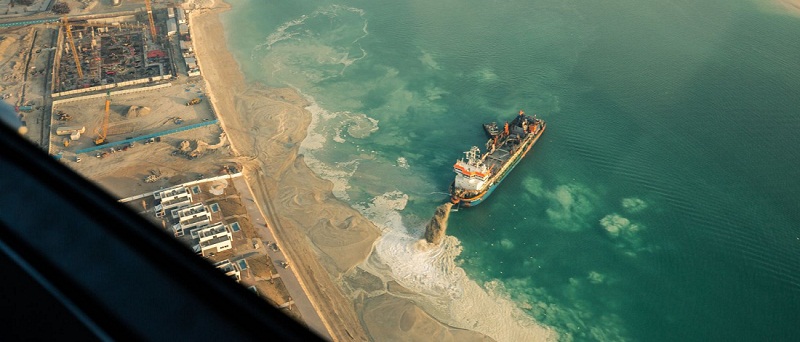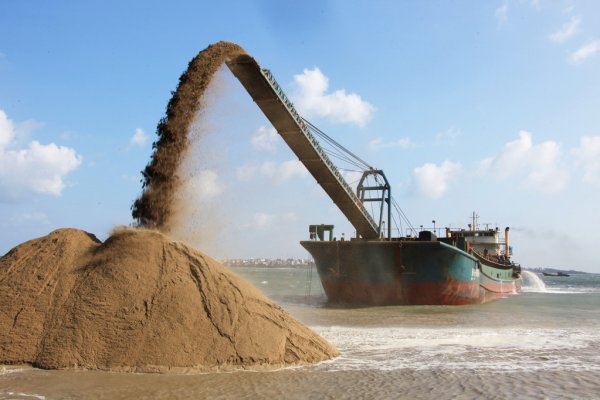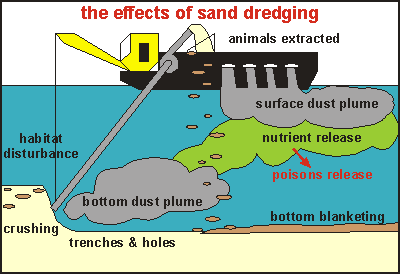Ocean Floor Sterilization Caused By Sand Extraction Is A Growing Environmental Concern

5 September 2023
Introduction: Sand Extraction
Sand, a material that appears to be abundant throughout beaches and underneath the ocean’s surface, is essential in forming coastal ecosystems and maintaining marine life. Sand dredging, however, is having a terrible influence on the delicate equilibrium of our oceans since it is an uncontrolled and frequently indiscriminate practice. Recent research and environmental reports are demonstrating the extent to which sand dredging is sterilizing the ocean floor, harming marine habitats, and upsetting the larger ecological web.
Sand Supply and Demand
Construction, manufacturing, and a number of industrial operations all involve sand, which is an essential part of our daily life. High-quality beach and seabed sand, which is best for building purposes, is in high demand rather than simply any sand. Sand demand has increased dramatically as urbanization and infrastructure development continue to grow.
To meet this demand, an industry of sand extraction has flourished, with companies resorting to dredging the ocean floor and shorelines to harvest sand. The consequences of this extraction are far-reaching, and they go beyond the immediate removal of sand from aquatic environments.

Sweeping up the ocean floor
Sand is removed from the ocean floor during the sand dredging operation, frequently with the aid of sizable ships fitted with strong suction dredgers. Not only is this practice depleting the ocean floor of its natural sand resources, but it is also seriously harming marine ecosystems.
The sterilization of the ocean floor is one of the most concerning effects. The growth of seagrasses, corals, and other organisms can be supported by the sand, which is an essential habitat for a variety of marine species. These ecosystems are lost when sand is removed, which forces several marine animals to shift and puts them in danger.
Environmental disruption
Sand habitat loss has a cascading effect on the ecosystem as a whole. These areas are necessary to many fish species for mating and shelter, and when these habitats vanish, the fish populations suffer. This has an impact on larger predators that eat these fish, which propagates along the food chain.
Additionally, sand removal from coastal regions causes beach erosion, which can cause coastal flooding, property damage, and the loss of livelihoods for coastal populations. In essence, sand dredging directly threatens human settlements that depend on the integrity of coasts in addition to harming marine ecosystems.
Inadequate Regulation and Illegal Sand Mining
The lack of efficient control and oversight in many areas is one of the most alarming features of sand dredging. Although several nations have put rules and laws in place to control sand extraction, enforcement is sometimes lax, which encourages illegal and unregulated sand mining.
Sand mining that is done illegally not only worsens environmental effects, but also maintains social and economic inequities. It frequently happens in exposed coastal locations when local communities might not have the means to safeguard their environment and way of life. They are frequently left to take the brunt of the harm brought on by sand dredging as a result.

Environmental Impacts
Sand dredging has longer-term effects on the environment in addition to its immediate effects on marine ecosystems. The natural flow of sediment, which is essential for preserving the stability of coastal habitats, is disrupted when sand from seas and coasts is removed. Without enough silt, coastal erosion worsens and the likelihood of flooding rises.
Sand extraction also adds to the release of pollutants that are bonded to sediment into the ocean, further lowering water quality and endangering marine life. The transport of nutrients and critical minerals, which are crucial for marine ecosystems, might be impacted by the disruption of normal sediment dynamics.
Worldwide Problems and actions Requests
The negative impacts of sand dredging are widespread and not limited to a particular area. The ecological and socioeconomic effects of unrestrained sand mining have been seen in coastal regions of Asia, Africa, the Americas, and Europe.
As a result, there is growing awareness on a global scale about the need for tougher laws and environmentally friendly procedures in the sand dredging sector. The urgency of tackling this issue has been underlined by groups like the International Union for Conservation of Nature (IUCN) and the United Nations Environment Programme (UNEP). They emphasize the significance of developing stronger regulatory frameworks, adopting sustainable sand mining practices, and funding research to better understand the effects of sand extraction.
Conclusion
Although sand dredging may appear like a typical activity, it has extensive and harmful effects on the ocean floor and coastal ecosystems over time. In addition to contributing to coastal erosion and water quality degradation, it sanitizes habitats and upends food networks. At the local, national, and international levels, immediate action is required to control and lessen the negative consequences of sand dredging.
Stricter laws, improved oversight and enforcement, investments in environmentally friendly alternatives to sand extraction, and public awareness campaigns are just a few of the many steps that must be taken to address this issue. We must strike a balance between the need for sand and the need to preserve marine ecosystems if we hope to maintain the health of our oceans and the prosperity of coastal communities. We have the best chance of stopping the trend of sterilizing our ocean floors and preserving the future of our seas if we work together.
Click here to join our Telegram chanel
You will get information, news, and support related to Merchant Navy.
